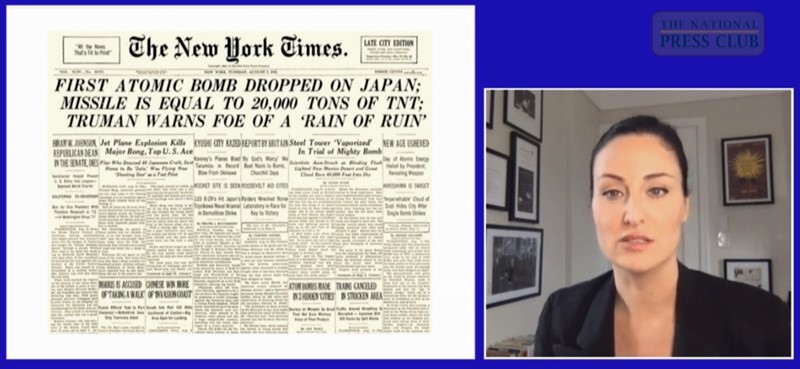Author Lesley M.M. Blume calls the Hiroshima bombing most covered and covered up stories ever

The U.S. Army took extreme steps to keep much of the aftermath of the atomic bombing of Hiroshima under wraps, journalist and author Lesley M.M. Blume said Wednesday at a National Press Club virtual book rap.
“The Hiroshima bombing was heavily covered, but due to U.S. Amy control it was also one of the most covered up stories," Blume told Club President Michael Freedman, who moderated the event.
Her book, "FALLOUT: The Hiroshima Cover-up and the Reporter Who Revealed It to the World," explores how New Yorker reporter John Hersey revealed the true impact of the first atomic bombing on Aug. 6, 1945.
Reporters including Leslie Nakashima, Wilfred Burchett, and George Weller filed stories soon after the bombing, but censors stopped their articles and their photographs disappeared, Blume said. When Hersey arrived in Japan in 1946, the Army maintained total control of who could enter Hiroshima.
“Everyone was monitored,” she said.
Hersey was a “Trojan Horse” reporter, Blume said, because of his favorable work during the war and his profile of Gen. Douglas MacArthur. The Army gave Hersey permission to spend two weeks in Hiroshima. Working with two priests as translators, Hersey interviewed six residents who had survived the atomic bomb. He intended, she said, to show the human side of the story of Hiroshima.
When Hersey returned to New York, editors William Shaw and Harold Ross edited the story in secret, revealing it to no one else at the magazine. As the article neared publication, President Truman signed the Atomic Energy Act of 1946. The editors, concerned the story might violate the act, had to decide whether to print the story as is, send it to the War Department for approval, or dump the story.
The New Yorker published Hersey’s story on Aug. 31, 1946. It took up most of the issue. Blume said Hersey’s story is one of the most influential works of investigative reporting ever written.
